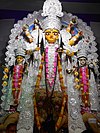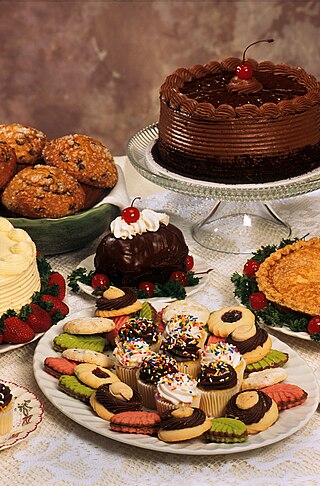
Dessert is a course that concludes a meal. The course consists of sweet foods, such as cake, biscuit, ice cream and possibly a beverage such as dessert wine and liqueur. Some cultures sweeten foods that are more commonly savory to create desserts. In some parts of the world there is no tradition of a dessert course to conclude a meal.

Bengali cuisine is the culinary style of Bengal, that comprises Bangladesh and the Indian states of West Bengal, Tripura and Assam's Karimganj district. The cuisine has been shaped by the region's diverse history and climate. It is known for its varied use of flavours including mustard oil, as well as the spread of its confectioneries and desserts. There is a strong emphasis on rice as a staple, with fish traditionally the most common protein. Freshwater fish are preferred to seafish, although barramundi, known as bhetki, is also common. Meat is also a common protein among Bengalis with chicken and mutton meat being the most popular. Beef is popular within the muslim community. In more recent times, lentils have begun to form a significant part of the diet. Many Bengali food traditions draw from social activities, such as adda, Poila Boishakh, Mezban, Iftar and Eid feast.

Kulfi is a frozen dairy dessert from the Indian subcontinent. It is often described as "traditional Indian ice cream". Kulfi originated in 16th-century Delhi during the Mughal era. It is part of the national cuisines of India and Pakistan. It is also popular in Bangladesh, Myanmar, Nepal, Sri Lanka, and the Middle East.

Gulab jamun is a sweet confectionary or dessert, originating in the Indian subcontinent and a type of mithai popular in India, Pakistan, Nepal, the Maldives and Bangladesh, as well as Myanmar. It is also common in nations with substantial populations of people with South Asian heritage, such as Mauritius, Fiji, Gulf states, the Malay Peninsula, Great Britain, South Africa, and the Caribbean countries of Jamaica, Trinidad and Tobago, Guyana, and Suriname.
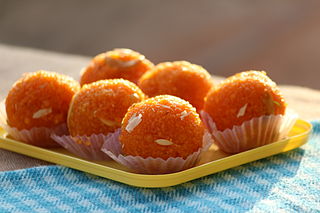
Laddu or laddoo is a spherical sweet from the Indian subcontinent made of various ingredients and sugar syrup or jaggery. It has been described as "perhaps the most universal and ancient of Indian sweets."

Rasgulla is a syrupy dessert popular in the eastern part of South Asia. It is made from ball-shaped dumplings of chhena dough, cooked in light sugar syrup. This is done until the syrup permeates the dumplings.

Barfi or burfi is a milk-based sweet from the Indian subcontinent with a fudge-like consistency. Its name comes from the Persian and Urdu word (barf) for snow. Barfi is consumed throughout India and Pakistan and is especially popular in North India. It is often served at celebrations and religious festivals such as Diwali and Holi.

Bangladeshi cuisine has been shaped by the region's history and river-line geography. Bangladesh has a tropical monsoon climate. The staple of Bangladesh is rice and fish. The majority of Bangladeshi people are ethnic Bengali, accustomed to Bengali cuisine, with a minority of non-Bengalis, many used to cuisines from different traditions and regions. Bangladeshi cooking features more meat dishes than the cuisine of neighbouring West Bengal, India.
Mithai (sweets) are the confectionery and desserts of the Indian subcontinent. Thousands of dedicated shops in India, Bangladesh, Nepal, Pakistan and Sri Lanka sell nothing but sweets.
Khoa, khoya, khowa or mawa is a dairy food widely used in the cuisines of the Indian subcontinent, encompassing India, Nepal, Bangladesh and Pakistan. It is made of either dried whole milk or milk thickened by heating in an open iron pan. It is lower in moisture than typical fresh cheeses such as ricotta. It is made up of whole milk instead of whey.

Ras malai, also known as rasamalei or roshomalai, is a dessert that was invented in Kolkata, British India, in the 20th century by Krishna Chandra Das. The dessert is called roshomalai in Bengali, ras malai in Hindi, and rasa malei in Odia. It is popular in India, Bangladesh and Pakistan.

Mishti doi is a fermented sweet doi (yogurt) originating from the Bengal region of the Indian subcontinent and common in the Indian states of West Bengal, Tripura, Assam's Barak Valley, and in the nation of Bangladesh. It is made with milk and sugar or jaggery. It differs from the plain yogurt because of the technique of preparation. There are many variations of mishti doi according to their popularity. Sweet curd of Nabadwip, Kolkata, Bogra, etc are very popular.
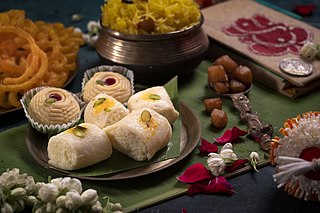
Sandesh is a dessert, originating from the Bengal region in the eastern part of the Indian subcontinent, created with milk and sugar. Some recipes of sandesh call for the use of chhena or paneer instead of milk itself. Some people in the region of Dhaka make a variety of sandesh called pranahara which is softer and made with mawa and yogurt. The Gupo/Gufo style of sandesh from Guptipara is considered by some to be the "first branded sweet of Bengal".

Lokma, also Loukoumades, is a dessert made of leavened and deep fried dough balls, soaked in syrup or honey, sometimes coated with cinnamon or other ingredients. The dish was described as early as the 13th century by al-Baghdadi as luqmat al-qādi, "judge's morsels".

Faloodeh or paloodeh is a traditional Iranian cold dessert similar to a sorbet. It consists of thin vermicelli-sized noodles made from starch in a semi-frozen syrup containing sugar and rose water. Faloodeh is often served with lime juice and sometimes ground pistachios.
Ledikeni or Lady Kenny is a popular Bangladeshi and Indian sweet consumed in West Bengal, India and Bangladesh. It is a light fried reddish-brown sweet ball made of Chhena and flour, soaked in sugar syrup. Ledikeni is named after Lady Canning, the wife of Charles Canning, the Governor General of India during 1856–62.

Malpua, or sometimes shortened to pua, is a sweetened breakfast served with morning tea or as a snack with afternoon tea or as a dessert originating from the East Indian subcontinent, popular in Bhutan, India, and Nepal.

Suji ka Halwa or Mohan Bhog is a type of halvah made by toasting semolina in a fat like ghee or oil, and adding a sweetener like sugar syrup, honey, or jaggery powder. It can be served for breakfast or as a dessert item. The basic recipe is made with just semolina, sugar or honey, ghee, and sometimes milk. Variations on this include dried or fresh fruits, nuts, shredded coconut, and other toppings. Wheat flour is often used as a substitute if semolina is not available, but virtually any starch can be used to make Suji ka Halwa.
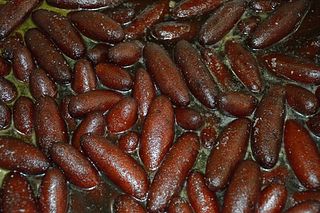
Lyangcha, Langcha, or Lemcha, is an Indian sweet dish prepared in West Bengal, Jharkhand, Odisha, Bihar, Assam, Tripura and also throughout Bangladesh. It is made from flour and milk powder by frying it and dipping it into sugar syrup for a long time. The origin of the sweet is in Bardhaman, West Bengal, India. The Government of West Bengal has begun the process of registering Geographical indication (GI) for Lyangcha.

